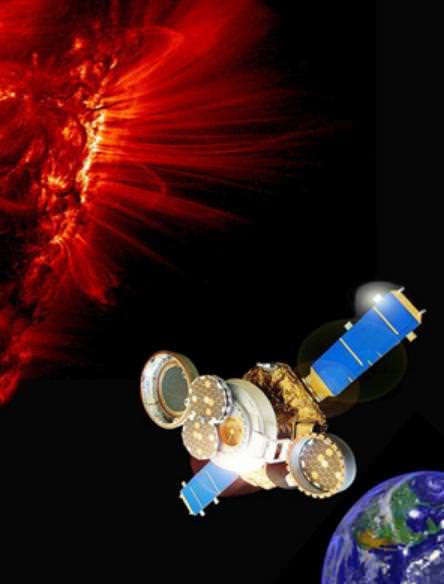[/caption]
For 886 days between 2001 and 2004, a tiny spacecraft named Genesis sat parked at Lagrange Point L1 quietly collecting solar wind samples. On Sept. 8, 2004, the spacecraft released a sample return capsule which bashed its way onto the Utah desert carrying its little payload. Despite the disastrous crash, solar-wind ions were found buried beneath the surface of the collectors and what they have to tell us about the possible formation of our solar system is pretty amazing.
In March 2005 the international scientific community was given the collectors to study – and one of their prime targets was the evolution of our solar system. How could these tiny particles give us clues as to our origin? According the bulk of evidence, it is surmised the outer layer of the Sun hasn’t changed in several billion years. If we are to agree this is a good basis for modeling our solar nebula, we could begin to understand the chemical processes which formed our solar system. For most rock-forming elements, there appears to be little fractionation of either elements or isotopes between the sun and the solar wind. Or is there?
“The implication is that we did not form out of the same solar nebula materials that created the sun — just how and why remains to be discovered,” said Kevin McKeegan, a Genesis co-investigator from the University of California, Los Angeles and the lead author of one of two Science papers published this week.
Using the deposits found on the collector plates, scientists found a higher rate of common oxygen isotopes and a lowered rate of rare ones – different from Earth’s ratios. The same held true of nitrogen composition.
“These findings show that all solar system objects, including the terrestrial planets, meteorites and comets, are anomalous compared to the initial composition of the nebula from which the solar system formed,” said Bernard Marty, a Genesis co-investigator from Centre de Recherches Petrographiques et Geochimiques in Nancy, France and the lead author of the second new Science paper. “Understanding the cause of such a heterogeneity will impact our view on the formation of the solar system.”
While more studies are in the making, this new evidence provides vital information which may correct how we initially perceived our beginnings. While these elements are the most copious of all, even slight differences make them as distinctive as salt and pepper.
“The sun houses more than 99 percent of the material currently in our solar system so it’s a good idea to get to know it better,” said Genesis principal investigator Don Burnett of the California Institute of Technology in Pasadena, Calif. “While it was more challenging than expected we have answered some important questions, and like all successful missions, generated plenty more.”
Original Story Source: JPL Genesis Mission News.


How much is a lowered rate? 25%???
http://genesismission.jpl.nasa.gov/gm2/news/features/isotopes.htm
Thanks for the link!
I like the photodissociation shield hypothesis, as the exogenous source idea (from Science comments) doesn’t quite mix with the ideas of Oort cloud admixture from other protoplanetary systems in the Sun’s apparently crowded birth environment. IIRC the latter is on the order of tens of percents at the most, which unless I am mistaken would take radically different ratios to explain the fractionating observations.
And incidentally the shield hypothesis would tear down the dominating importance of the frost line, preserving water in the inner system and potentially explaining why there is so much water in inner system asteroids.
Much as I like the linked page, it is old and the graph of Sun position at ~ – 4 % percent oxygen ratio (SMOW standard) has an arrow implying out of graph bounds. Indeed the Science papers say:
“we conclude that essentially all rocky materials in the inner solar system were enriched in 17O and 18O, relative to 16O, by ~7%”
and
“implanted solar wind nitrogen has a 15N/14N ratio of 2.18 ± 0.02 × 10?3 (that is, ?40% poorer in 15N relative to terrestrial atmosphere).”
Now the geometric mean of those ratios would be ~ – 25 % (relative Earth)! Good guess, HeadAroundU.
Um… at the second paragraph, there’s a missing preposition “to” in the third sentence intro: “According [to] the bulk of evidence,…”
I WANT MORE INFORMATION ABOUT THIS. I REQUEST TO ALL The scientists that please give me all information about this universe including earth also
I WANT MORE INFORMATION ABOUT THIS. I REQUEST TO ALL The scientists that please give me all information about this universe including earth also before my death